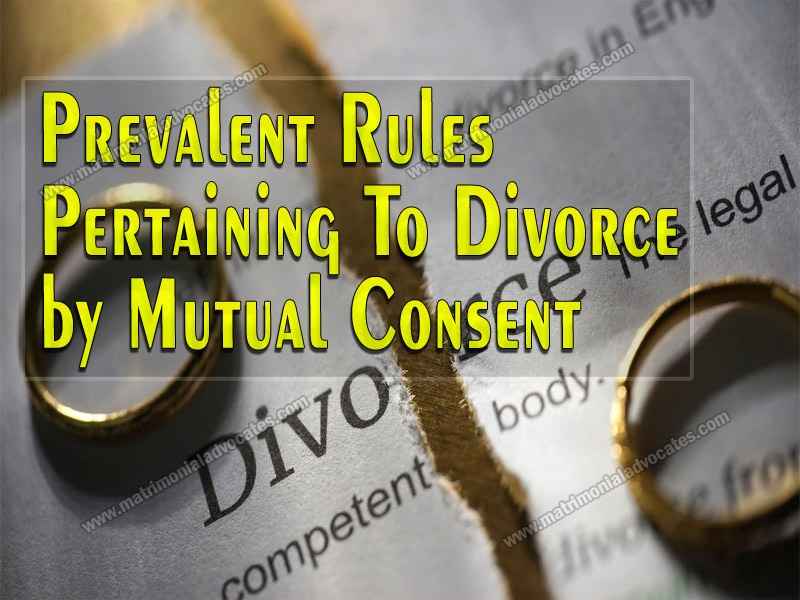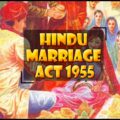
Introduction
Divorce by mutual consent is a legal process of separation after marriage, when both the parties (husband and wife) wants to separate with their own will and terminate the discharge of marital obligations towards each other.
Various legislations containing the provision for divorce by mutual consent in India
- Divorce laws for Hindus including Sikhs, Jains and Buddhists are provided under the Hindu Marriage Act, 1955 (Section 13)
- Divorce laws for Christians are governed under the Indian Divorce Act, 1869 (Section 10 A)
- Divorce laws for Muslims are governed under their personal laws of Divorce and Dissolution of Marriage Act, 1939 and the Muslim Women (Protection of Rights on Divorce) Act, 1986.
- Divorce laws for all the inter-religion marriages are governed under a secular law i.e. the Special Marriage Act, 1954. (Section 28)
- The Parsi Marriage and Divorce Act, 1936.
Minimum Conditions to be fulfilled for obtaining divorce by mutual consent.
Discussing the divorce by mutual consent at length under Section 13 of the Hindu Marriage Act, 1955, the minimum requirements that should be followed for obtaining a divorce by mutual consent.
- The petition must be presented to the court jointly by both the parties containing the agreement between the parties in respect of the following :-
- Child Custody – Which partner will get the child custody after divorce.
- Alimony/ Maintenance – The final arrangement of exchange of monetary benefits between the parties that can be of recurring nature or a one time payment in lumpsum or payable in installments.
- Settlement of Property and Assets – Settling the ownership rights of property and asset between the parties(Husband and wife).
- The court hearing after filing the petition should also be attended by both the parties.
- The husband and wife must have been living separately for at least 1 year from each other.
- All the possibilities of settlement/ conciliation and resolution of differences have been exhausted and parties are unable to live together.
- The parties should be acting out of their own free will and consent which is free from any kind of coercion have decided to get the divorce by mutual consent.
Duration / Time involved in a divorce by mutual consent.
As per law, before filing a joint petition for divorce by mutual consent the parties are required to live separately for 1 year. After the minimum time period of separation, the parties can approach the Family Court for getting the divorce and record statement for first motion under Section 13B (1) of Hindu Marriage Act, 1955.
After recording of the statement under Section 13 B(1) the parties are given a cooling off period of 6 months to re think and revisit their decision to proceed with the divorce. After the elapse of the cooling off period, the parties can file for second motion under Section 13 B(2), if they stick to their decision of getting separated.
The second motion can be filed anytime within 18 months from the date of first motion.
The Hon’ble Supreme Court in 2017 held that the minimum cooling off period of six months can be relaxed by the trial court in certain situations and the estranged couple, who are seeking divorce with mutual consent, can file waiver application after a week of filing the first motion.[1]
Can a spouse withdraw his/ her petition for divorce?
During the 6 month cooling off period i.e. the time gap between the first and the second motion, either of the spouses can withdraw from a mutual consent divorce by filing an application before the court, stating that they no longer intend to get a mutual consent divorce. In such a situation, the other spouse only has one option left i.e. to file and fight a contested divorce.
Necessary documentation required for filing petition for divorce by mutual consent
- Joint Petition signed by both spouses along with attested affidavit.
- Photographs of parties
- ID proofs of both parties
- Address Proof
- Marriage Photo and Marriage Card
- In Case of second motion, original certified copy of the order f first motion.
In Case of second motion, the application for waiver of six month time period.
Scenario post the judgment of Rajat Gupta and Ors. Versus Rupali Gupta and Ors. [1]
The above witnessed the issue in which at the time of recording of the first motion, the wife undertook to extend her consent to file the second motion and fully co operate with the husband for getting the decree of second motion. Later, after the first motion and before the second motion, the wife withdrew her consent for getting the decree of divorce by mutual consent.
Consequently the Court held that the distinguishing feature of Section 13B of the Act, 1955 is the mutuality of the consent to divorce proceedings. The said element of mutual consent is a sine qua non (essential) for passing a decree of divorce. This being the legal position, the defaulting party cannot be compelled to file or appear in the petition or motion or both, to obtain divorce by mutual consent.
At the same time, a defaulting party can be held liable for civil contempt on the ground of breaching the terms and conditions incorporated in an undertaking given to the court or made a part of a consent order/decree. The Contempt of Courts Act, 1971 has empowered the Courts to entertain the petition.
In a proceeding of divorce by mutual consent either of the party can withdraw their consent at any stage till the final decree is passed by the Court.
New Guidelines to be followed in mutual consent divorce while making the settlement agreement and such terms are to be included in the affidavit of the parties filed along with the petition.
- Record in clear, specific and unambiguous language, the terms/stipulations agreed upon between the parties;
- Record in clear, specific, simple and unambiguous language, the mode, manner, mechanism and/or method for the implementation or compliances of the terms/stipulations agreed upon between the parties;
- Record an undertaking of the parties that they will abide by and be bound by the agreed terms /stipulations of the settlement agreement;
- Stipulate a fine or penalty as may be agreed upon, in the event of a default of the agreed terms/stipulations of the settlement agreement by either side;
- Provide for the consequences of the breach of the terms/stipulations of the settlement agreement;
- Record a declaration of both the parties in unequivocal and unambiguous terms that they have agreed on each and every term recorded in the settlement agreement, after carefully reading over and fully understanding and appreciating the contents, scope and effect thereof, as also the consequences of the breach thereof, including payment of the fine/penalty, if so agreed;
- The settlement agreement must state that the terms have been settled between the parties of their own free will, violation and consent and without there being any undue pressure, coercion, influence, misrepresentation or mistake (both of law and fact), in any form whatsoever. It should also be stated that the settlement agreement has correctly recorded the said agreed terms.
- The settlement agreement may include a term/stipulation that the parties have agreed that they would dissolve their marriage by mutual consent, which necessarily has to be in accordance with the law, as provided under Section 13B of the Hindu Marriage Act.
- The settlement agreement may include other terms/stipulations settled between the parties including payment of money, transfer of moveable/immovable properties as for example, jewellery/stridhan, maintenance amounts, alimony etc. or plans for the custody of the children/visitation rights of children. The said terms must be scrutinized by the court to satisfy itself that they are in accordance with the spirit of law and are enforceable and executable. (4) On the said settlement agreement being presented, along with a report (in the event the settlement is arrived at through mediation or conciliation or Lok Adalat) to the court where the proceedings between the parties are sub judice, the said court should apply the procedure and principles to be followed by a civil court under and/or analogous to the provisions of Order XXIII Rule 3 of the Code of Civil Procedure.
- To avoid any ambiguity or misunderstanding on the part of either of the parties, at a later stage, a clear and unambiguous undertaking to the court must be recorded.
- The statements of the parties may be recorded by the court after putting them on oath in the following manner:-
a) the parties should affirm the terms of the settlement;
b) the fact that they have executed the settlement agreement after fully understanding the terms, consents, effect and consequences thereof;
c) that the same has been arrived at of their own free will and volition;
d) that they would be liable for penal consequences in case of breach. In the alternative, the court may direct the parties to file their respective affidavits affirming the terms and conditions of the settlement. If considered necessary, the court may ask the parties to formally prove not only the said affidavits, but also the settlement agreement executed by them.
12. The Court must apply its judicial mind to satisfy itself that the settlement arrived at between the parties is not only bonafide, equitable and voluntary in nature, but is enforceable in law and is not opposed to public policy. The court must also satisfy itself that there is no impediment of any nature in accepting the said settlement and the undertakings of the parties and binding them down thereto. After perusing the settlement agreement, recording the statements of the parties and/or examining the affidavits filed by them, as the case may be, the Court must specifically accept the statements of the parties and/or the undertakings given by them as also the terms/stipulations of the settlement agreement and direct that they shall remain bound by the same.
13. Depending upon the jurisdiction of the Court, appropriate orders/decree be passed. The said order/decree, as the case may be, should clearly spell out the consequences of breach, violation of any of the terms of the settlement agreement. In the event any fine/penalty has been agreed to be paid under the terms of the settlement agreement or in case of breach of the same, the order shall state that the said amount will be recovered from the defaulting party. The parties must be informed that they will be liable to be punished for contempt of court in the event of any breach/violation/willful/deliberate disobedience of the terms of the settlement agreement.
14. A decree/order shall be passed by the Court in respect of the subject matter of the suit/proceedings. For those matters/disputes that are not the subject matter of the suit/proceedings, where a settlement has been reached before a non-adjudicatory ADR fora, the Court shall direct that the settlement agreement shall be governed by Section 74 of the Arbitration and Conciliation Act (in case of a settlement through conciliation) and/or Section 21 of The Legal Services Authorities Act, 1987. (in respect of a settlement by a Mediator or a Lok Adalat) [Refer: Afcons Infrastructure Ltd. (supra)] (12) If the obligations under the settlement agreement/undertaking/consent order/decree are breached by one party, then, at the instance of the aggrieved party, appropriate orders shall be passed in accordance with law.
15. For breach of the undertaking given to the concerned court or willful/deliberate violation of a consent order/decree, if so approached or otherwise, the court would take appropriate action as permissible in law to enforce compliance by the defaulting party by exercising contempt jurisdiction as contemplated under Section 2(b) of the Contempt of Court Act, 1971. This will however exclude any coercive orders compelling the defaulting party to give its consent for grant of a decree of divorce by mutual consent, notwithstanding any settlement/undertaking given by the parties before any fora.
Take away points from the article
- The essential characteristic of a divorce by mutual consent is the unequivocal consent of both the spouses.
- The parties should be acting out of their own free will and consent which is free from any kind of coercion have decided to get the divorce by mutual consent.
- Under Hindu Marriage Act, 1955, the husband and wife must have been living separately for at least 1 year from each other.
- All the possibilities of settlement/ conciliation and resolution of differences have been exhausted and parties are unable to live together.
- The minimum cooling off period of six months can be relaxed by the trial court in certain situations and the estranged couple, who are seeking divorce with mutual consent, can file waiver application after a week of filing the first motion.
- If a settlement agreement / Memorandum of Understanding (MOU) has been executed between the parties/ spouses, then also the consent can be withdrawn by either of the spouse.
- The said consent can to be withdrawn any time after recording the statement under Section 13 B (1) (first motion) but before the recording of statement under Section 13B(2) (second motion).
- Hence, in a proceeding of divorce by mutual consent either of the party can withdraw their consent at any stage till the final decree is passed by the Court.
- The withdrawal of consent can result in initiation of proceedings under Contempt of Courts Act, 1971 against the defaulting party/ spouse.
- Various guidelines to be adhered to while executing the settlement agreement between spouses who are desirous of getting divorce by mutual consent.
[1] The judgment came in 2017 where the couple was living separately for a period of 8 years before filing the petition.
[2] Decided by Delhi High Court on 15.05.2018 through bench comprising of Hon’ble Ms. Justice Hima Kohli and Hon’ble Ms. Justice Deepa Sharma.





